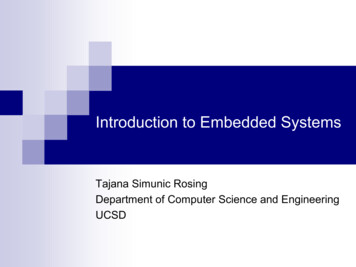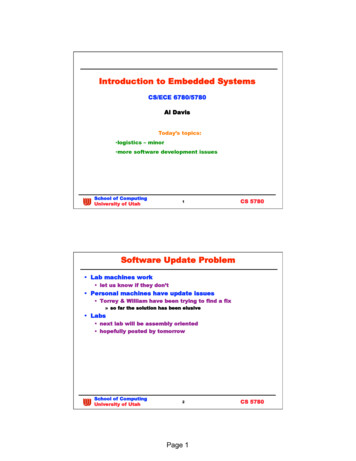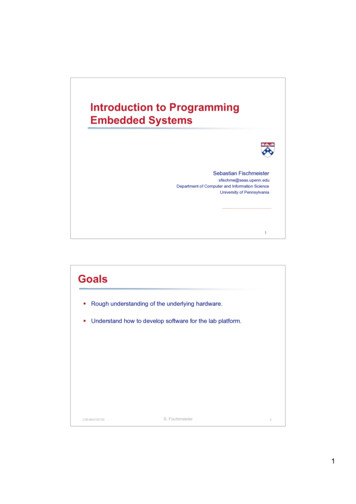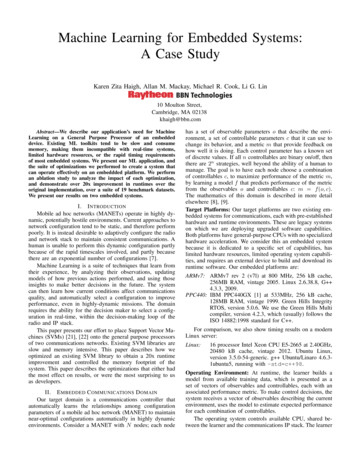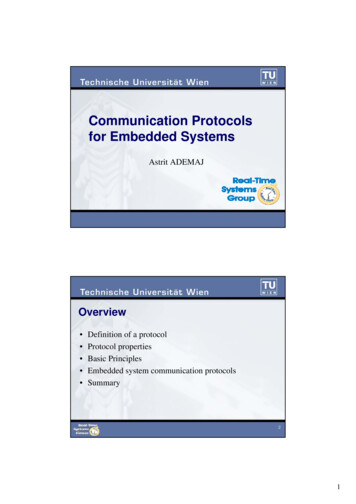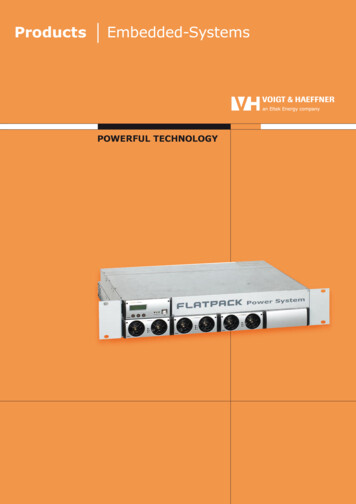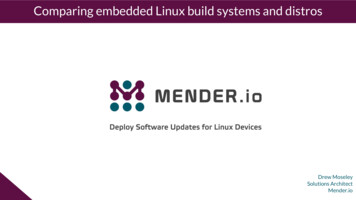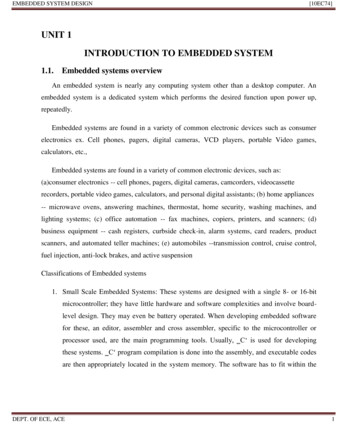
Transcription
Introduction toEmbedded SystemsSanjit A. SeshiaUC BerkeleyEECS 149/249AFall 2015 2008-2015: E. A. Lee, A. L. Sangiovanni-Vincentelli, S. A. Seshia. All rightsreserved.Chapter 6 - Models of Computation:Synchronous/Reactive and DataflowConcurrent Composition:Alternatives to ThreadsThreads yield incomprehensible behaviors.Composition of State Machines: Side-by-side composition Cascade composition Feedback compositionWe will begin with synchronous composition, an abstractionthat has been very effectively used in hardware design andis gaining popularity in software design.Lee & Seshia, UC Berkeley: 2 1
Recall: Actor Model for State MachinesExpose inputs and outputs, enabling composition:Lee & Seshia, UC Berkeley: 3Recall: Actor Model of Continuous-Time SystemsA system is a function thataccepts an input signal andyields an output signal.The domain and range ofthe system function aresets of signals, whichthemselves are functions.Parameters may affect thedefinition of the function S.Lee & Seshia, UC Berkeley: 4 2
Recall: Composition of ActorsAngular velocityappears on bothsides. The semantics(meaning) of themodel is the solutionto this equation.We will now generalize this notion of composition.Lee & Seshia, UC Berkeley: 5Side-by-Side CompositionSynchronous composition: the machines reactsimultaneously and instantaneously.Lee & Seshia, UC Berkeley: 6 3
Cascade CompositionSynchronous composition: the machines reactsimultaneously and instantaneously, despite the apparentcausal relationship!Lee & Seshia, UC Berkeley: 7Synchronous Composition:Reactions are Simultaneous and InstantaneousConsider a cascade composition as follows:Lee & Seshia, UC Berkeley: 8 4
Synchronous Composition:Reactions are Simultaneous and InstantaneousIn this model, you must not think of machine A as reacting before machineB. If it did, the unreachable states would not be unreachable.unreachableLee & Seshia, UC Berkeley: 9Feedback CompositionTurns out everything can be viewed as feedback composition Lee & Seshia, UC Berkeley: 10 5
Observation: Any Composition is aFeedback Compositions SNThe behavior of the systemis a “fixed point.”Lee & Seshia, UC Berkeley: 11Fixed Point SemanticsConsider aninterconnection of actorsReorganizeWe seek an s S Nthat satisfies F(s) s.Such an s is called afixed point.Abstract actorsAbstract signalss SNWe would like thefixed point to existand be unique. Andwe would like aconstructiveprocedure to find it.It is the behavior ofthe system.Lee & Seshia, UC Berkeley: 12 6
Data TypessxyLee & Seshia, UC Berkeley: 13Firing FunctionssxyLee & Seshia, UC Berkeley: 14 7
Well-Formed FeedbacksxyLee & Seshia, UC Berkeley: 15Well-Formed ExampleLee & Seshia, UC Berkeley: 16 8
Composite MachineLee & Seshia, UC Berkeley: 17Ill-Formed Example 1 (Existence)Lee & Seshia, UC Berkeley: 18 9
Ill-Formed Example 2 (Uniqueness)Lee & Seshia, UC Berkeley: 19Constructive Semantics: Single SignalLee & Seshia, UC Berkeley: 20 10
Non-Constructive Well-Formed State MachineLee & Seshia, UC Berkeley: 21Must / May AnalysisLee & Seshia, UC Berkeley: 22 11
Constructive Semantics: Multiple SignalsLee & Seshia, UC Berkeley: 23Constructive Semantics: Multiple ActorsProcedure is the same.Lee & Seshia, UC Berkeley: 24 12
Constructive Semantics: Arbitrary StructureProcedure is the same.A state machine language with constructive semanticswill reject all compositions that in any iteration fail tomake all signals known.Such a language rejects some well-formed compositions.Lee & Seshia, UC Berkeley: 25Synchronous Reactive Models: ConclusionsThe emphasis of synchronous composition, in contrastwith threads, is on determinate and analyzableconcurrency.Although there are subtleties with synchronousprograms, all constructive synchronous programs have aunique and well-defined meaning.Automated tools can systematically explore all possiblebehaviors. This is not possible in general with threads.Lee & Seshia, UC Berkeley: 26 13
Introduction toEmbedded SystemsChapter 6: Dataflow ModelsSimple Example: Spectrum AnalysisNot timecritical pathTime critical pathHow do we keep thenon-time critical pathfrom interfering withthe time-critical path?Dataflow Models, UC Berkeley: 28 14
A Solution with ThreadsThread AThread BTime critical pathCreate two threads: A has low priority B has high priorityWhy? RMS does not apply because thereare dependencies.EDF with precedences applies andis optimal w.r.t. feasibility, except forhow to assign deadlines.How to implement thecommunication between threads?Dataflow Models, UC Berkeley: 29Abstracted Version of the Spectrum Example:EDF scheduling81Precedence graph1Suppose that C requires 8data values from A to execute. Suppose further that Ctakes much longer to execute than A or B. EDF schedule:scheduleDataflow Models, UC Berkeley: 30 15
Dataflow ModelsActor AFIFO bufferActor BBuffered communication between concurrent components (actors).Static scheduling: Assign to each thread a sequence of actorinvocations (firings) and repeat forever.Dynamic scheduling: Each time dispatch() is called, determinewhich actor can fire (or is firing) and choose one.May need to implement interlocks in the buffers.Dataflow Models, UC Berkeley: 31Streams: The basis for Dataflow modelsDataflow Models, UC Berkeley: 32 16
DataflowFiring rules:the number oftokensrequired to firean actor.Dataflow Models, UC Berkeley: 33Buffers for Dataflow Unbounded buffers require memory allocation and deallocationschemes.Bounded size buffers can be realized as circular buffers or ringbuffers, in a statically allocated array. A read pointer r is an index into the array referring to the first emptylocation. Increment this after each read.A fill count n is unsigned number telling us how many data items arein the buffer.The next location to write to is (r n ) modulo buffer length.The buffer is empty if n 0The buffer is full if n buffer lengthCan implement n as a semaphore, providing mutual exclusion forcode that changes n or r.Dataflow Models, UC Berkeley: 34 17
Synchronous Dataflow (SDF)If the number of tokens consumed and produced by thefiring of an actor is constant, then static analysis can tellus whether we can schedule the firings to get a usefulexecution, and if so, then a finite representation of aschedule for such an execution can be created.Dataflow Models, UC Berkeley: 35Balance EquationsLet qA, qB be the number of firings of actors A and B.Let pC, cC be the number of tokens produced andconsumed on a connection C.Then the system is in balance if for all connections CqA pC qB cCwhere A produces tokens on C and B consumes them.Dataflow Models, UC Berkeley: 36 18
ExampleConsider this example, where actors and arcs arenumbered:The balance equations imply that actor 3 must fire twiceas often as the other two actors.Dataflow Models, UC Berkeley: 37Compactly Representing the Balance Equationsproduction/consumption matrix 1 1 0 0 2 1 2 0 1 Actor 1balance equationsConnector 1 q1 q q2 q3 firing vector 0 q 0 0 0 Dataflow Models, UC Berkeley: 38 19
Question on initial example What is the production/consumption matrix in this case?811Dataflow Models, UC Berkeley: 39Question on initial example What is the production/consumption matrix in this case?811 1 0 1 1 8 0 Dataflow Models, UC Berkeley: 40 20
ExampleA solution to the balance equations: 1 q 1 2 1 1 0 0 2 1 2 0 1 q 0This tells us that actor 3 must fire twice as often as actors 1 and 2.Dataflow Models, UC Berkeley: 41ExampleBut there are many solutions to the balance equations: 0 2 1 1 q 1 q 0 q 2 q 1 q 4 2 2 0 2 q 0For “well-behaved” models, there is a unique leastpositive integer solution.Dataflow Models, UC Berkeley: 42 21
Least Positive Integer Solution to the BalanceEquationsNote that if pC, cC , the number of tokens produced andconsumed on a connection C, are non-negative integers,then the balance equation,qA pC qB cCimplies: qA is rational if and only if qB is rational. qA is positive if and only if qB is positive.Consequence: Within any connected component, if thereis any non-zero solution to the balance equations, thenthere is a unique least positive integer solution.Dataflow Models, UC Berkeley: 43Consistent ModelsAn SDF model is consistent if there exists a non-zerosolution to the balance equations.Dataflow Models, UC Berkeley: 44 22
Example of an Inconsistent Model:No Non-Trivial Solution to the Balance Equations 1 1 0 0 1 1 2 0 1 There are no nontrivial solutions to the balanceequations.Note that this model can execute forever, but it requiresunbounded memory.Dataflow Models, UC Berkeley: 45Structured DataflowLabVIEW uses homogeneous SDF augmented withsyntactically constrained forms of feedback and ratechanges: While loops Conditionals SequencesLabVIEW models are decidable.Dataflow Models, UC Berkeley: 46 23
Many other concurrent MoCs have been explored (Kahn) process networksCommunicating sequential processes (rendezvous)Time-driven modelsMore dataflow variants: cyclostatic Heterochronous Petri nets Dataflow Models, UC Berkeley: 47Introduction toEmbedded SystemsMaterial for Further Reading 24
Abstracted Version of the Spectrum Example:Non-preemptive schedulingIs this dataflowmodel dynamic?Is it homogeneous?Assume infinitely repeatedinvocations, triggered byavailability of data at A.811Suppose that C requires 8 data values from A to execute.Suppose further that C takes much longer to executethan A or B. Then a schedule might look like this: scheduleThis suffersfrom jitter.Note that each period is EDF.Dataflow Models, UC Berkeley: 49Uniformly Timed ScheduleA preferable schedule would space invocations ofA and B uniformly in time, as in: minimum latencyDataflow Models, UC Berkeley: 50 25
Non-Concurrent Uniformly Timed ScheduleNotice that in this schedule, the rate at which A and Bcan be invoked is limited by the execution time of C. No jitter, but utilization is poor.Dataflow Models, UC Berkeley: 51Concurrent Uniformly Timed Schedule:Preemptive scheduleWith preemption, the rate at which A and B can beinvoked is limited only by total computation:thread 1:thread 2:preemptions high priority low priorityDataflow Models, UC Berkeley: 52 26
Ignoring Initial Transients,Abstract to Periodic TaskssampleTime 8sampleTime 1sampleTime 1In steady-state, the execution follows a simple periodicpattern:thread 1: thread 2: This follows theprinciples of ratemonotonicscheduling (RMS).Dataflow Models, UC Berkeley: 53Requirement 1: Bounded Buffersinterlockthread 1: sampleTime: 8sampleTime: 1 sampleTime: 1thread 2: If the execution of C runs longer than expected, to keepthe buffer bounded, thread 1 must be delayedaccordingly. This can be accomplished with semaphoresynchronization. But there are alternatives: Throw an exception to indicate timing failure. “Anytime” computation: use incomplete results of CDataflow Models, UC Berkeley: 54 27
Requirement 2: Respect Data DependencesampleTime: 8 thread 1:sampleTime: 1 sampleTime: 1thread 2:interlock If the execution of C runs shorter than expected, datadeterminacy requires that thread 2 be delayedaccordingly. That is, it must not start the next executionof C before the data is available.Dataflow Models, UC Berkeley: 55In Dataflow, Interlocks and Built-in Buffering takecare of these dependenciesFor dataflow, a one-time interlock ensures sufficient dataat the input of C for the first invocation: thread 1:high priorityperiodic interlocksthread 2:first-time interlock low priorityDataflow Models, UC Berkeley: 62 28
Dataflow: many variantsDataflow Models, UC Berkeley: 67Necessary and sufficient conditionsConsistency is a necessary condition to have a(bounded-memory) infinite execution.Is it sufficient?Dataflow Models, UC Berkeley: 71 29
Deadlock 11111ABIs this diagram consistent?Dataflow Models, UC Berkeley: 72Deadlock 2Some dataflow models cannot execute forever. In theabove model, the feedback loop injects initial tokens, butnot enough for the model to execute.Dataflow Models, UC Berkeley: 73 30
SDF: from static analysis to schedulingGiven: SDF diagramFind: a bounded-buffer schedule, if it existsStep 0: check whether diagram is consistent. If not, thenno bounded-buffer schedule exists.Step 1: find an integer solution to q 0.Step 2: “decompose” the solution q into a schedule,making sure buffers never become negative.Dataflow Models, UC Berkeley: 74Step 2: “decomposing” the firing vectorExample 1:Schedule (1;2;3;3) 0 b 0 0 1 q 1 2 1 b 0 2 Fire 1 0 q 1 2 0 b 2 2 Fire 2 0 q 0 2 0 b 1 1 Fire 3 0 q 0 1 0 b 0 0 Fire 3 0 q 0 0 Dataflow Models, UC Berkeley: 75 31
Step 2: “decomposing” the firing vectorExample 2:1111ABWhat happens if we try to runthe previous procedureon this example?So, we have both necessaryand sufficient conditions forscheduling SDF graphs.Dataflow Models, UC Berkeley: 76A Key Question: If More Than One Actor isFireable in Step 2, How do I Select One?Optimization criteria that might be applied: Minimize buffer sizes. Minimize the number of actor activations. Minimize the size of the representationof the schedule (code size).See S. S. Bhattacharyya, P. K. Murthy, and E. A. Lee, SoftwareSynthesis from Dataflow Graphs, Kluwer Academic Press, 1996.Beyond our scope here, but hints that it’s an interesting problem Dataflow Models, UC Berkeley: 77 32
What consumption rate?Dynamic DataflowImperativeequivalent:while (true) {x f1();b f7();if (b) {y f3(x);} else {y f4(x);}f6(y);}What production rate?The if-then-else model is not SDF.But we can clearly give a boundedquasi-static schedule for it:(1, 7, 2, b?3, !b?4, 5, 6)guardDataflow Models, UC Berkel
Introduction to Embedded Systems Chapter 6: Dataflow Models Dataflow Models, UC Berkeley: 28 Simple Example: Spectrum Analysis How do we keep the non-time critical path from interfering with the time-critical path? Time critical path Not time critical path 15 Dataflow Models, UC Berkeley: 29 A Solution with Threads Time critical path Create two threads: A has low priority B has high .

